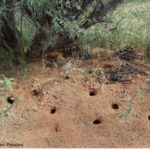News, Kangaroo rat research aims to prepare for future extremes
Geotechnical engineer and assistant professor Idil Akin from Washington State University became fascinated with how kangaroo rats can build burrows which withstand harsh climates for generations. How, with such a simple material like soil, could they make such durable structures that could withstand dry climates, humidity fluctuations, and flash flooding? Through her research into these animals, Akin learned that kangaroo rat burrows were hotspots for microbes. She discovered that the rats stored the microbes in their cheeks and on their feet and then deposited them throughout the burrows, leading to a thriving microbial community. Akin, along with a team of collaborators from different disciplines, is now in the process of studying how these microbial communities affect the structural integrity of the burrows. Their research will involve taking microbes from kangaroo rat burrows and growing them in sandy soil. The new microbe and soil mixture will then be tested for its strength as well as mechanical and hydraulic behavior while being subjected to different weather conditions.
Learn about our two Decals!
 Click here to find out more about our Fall Bioinspired Design Decal and our Spring Bioinspired Design in Action Decal – ALL MAJORS are welcome.
Click here to find out more about our Fall Bioinspired Design Decal and our Spring Bioinspired Design in Action Decal – ALL MAJORS are welcome.Berkeley BioDesign Community
 Click here to learn about the BioD: Bio-Inspired Design @ Berkeley student organization or here to signup for more info.
Click here to learn about the BioD: Bio-Inspired Design @ Berkeley student organization or here to signup for more info.Search
Student Login





I imagine that the neurological circuits underlying these processes are governed by both 2d spacing maps with their brains as…
to reduce the impact of car accidents, it may be possible to study the force diverting physics of cockroaches to…
you see this type of head-bobbing stability in many avian creatures related to pigeons like chickens. the head ability to…
not like they taught horses how to run! this is an example of convergent evolution where both sea creatures and…
The brain functions in a similar way with neuronal connections. our brains are able to utilize the multiplicity of connections…